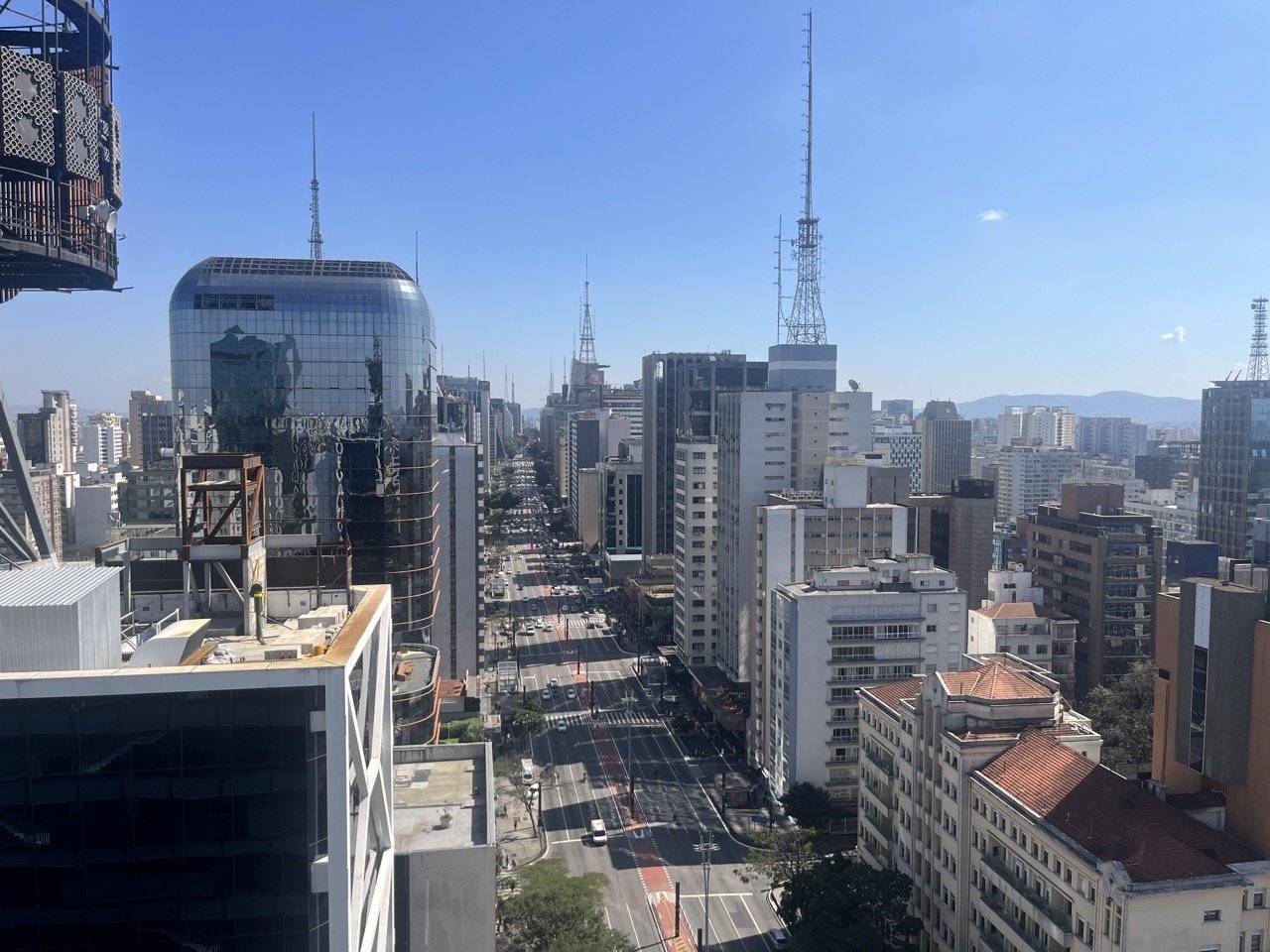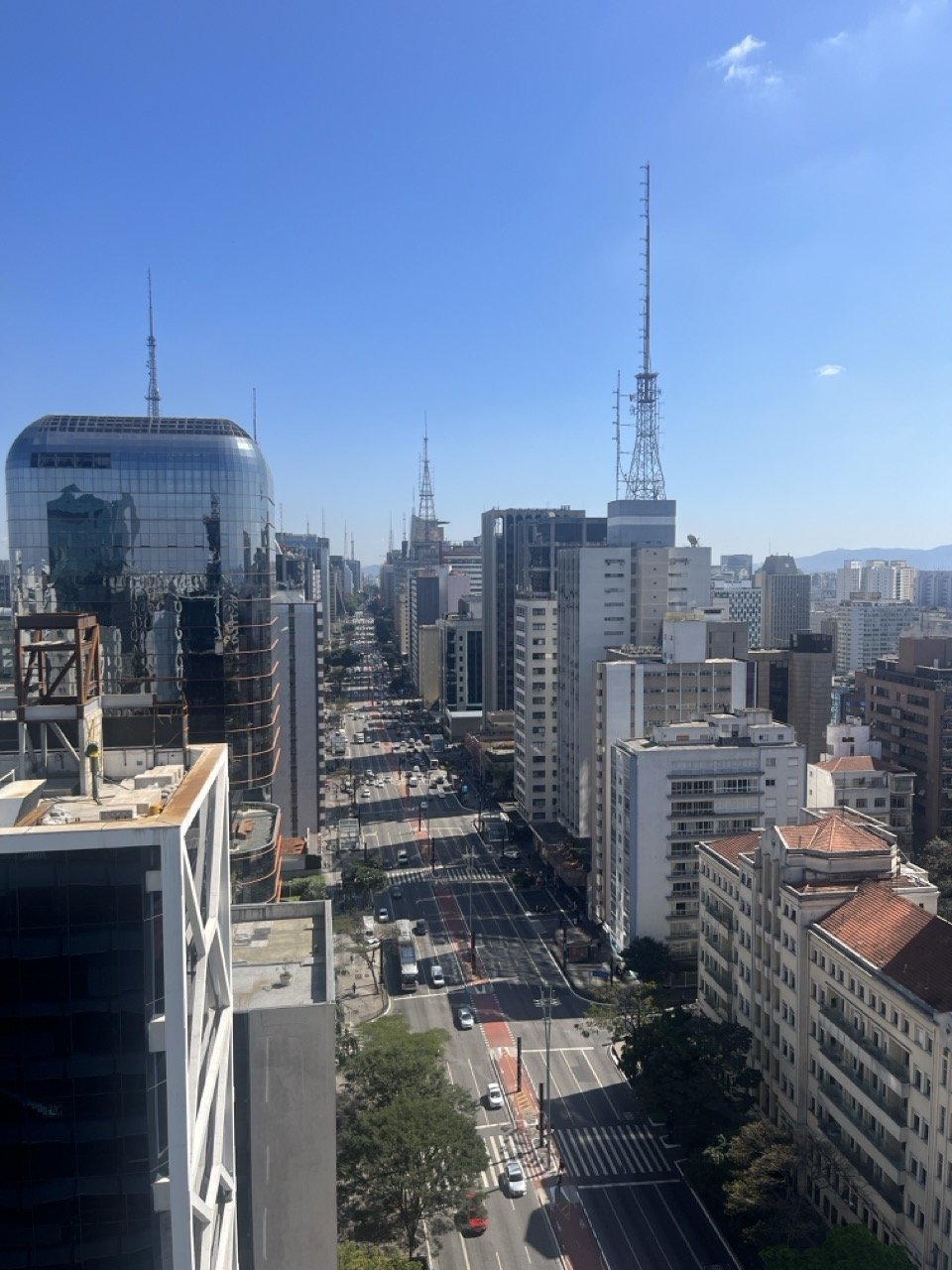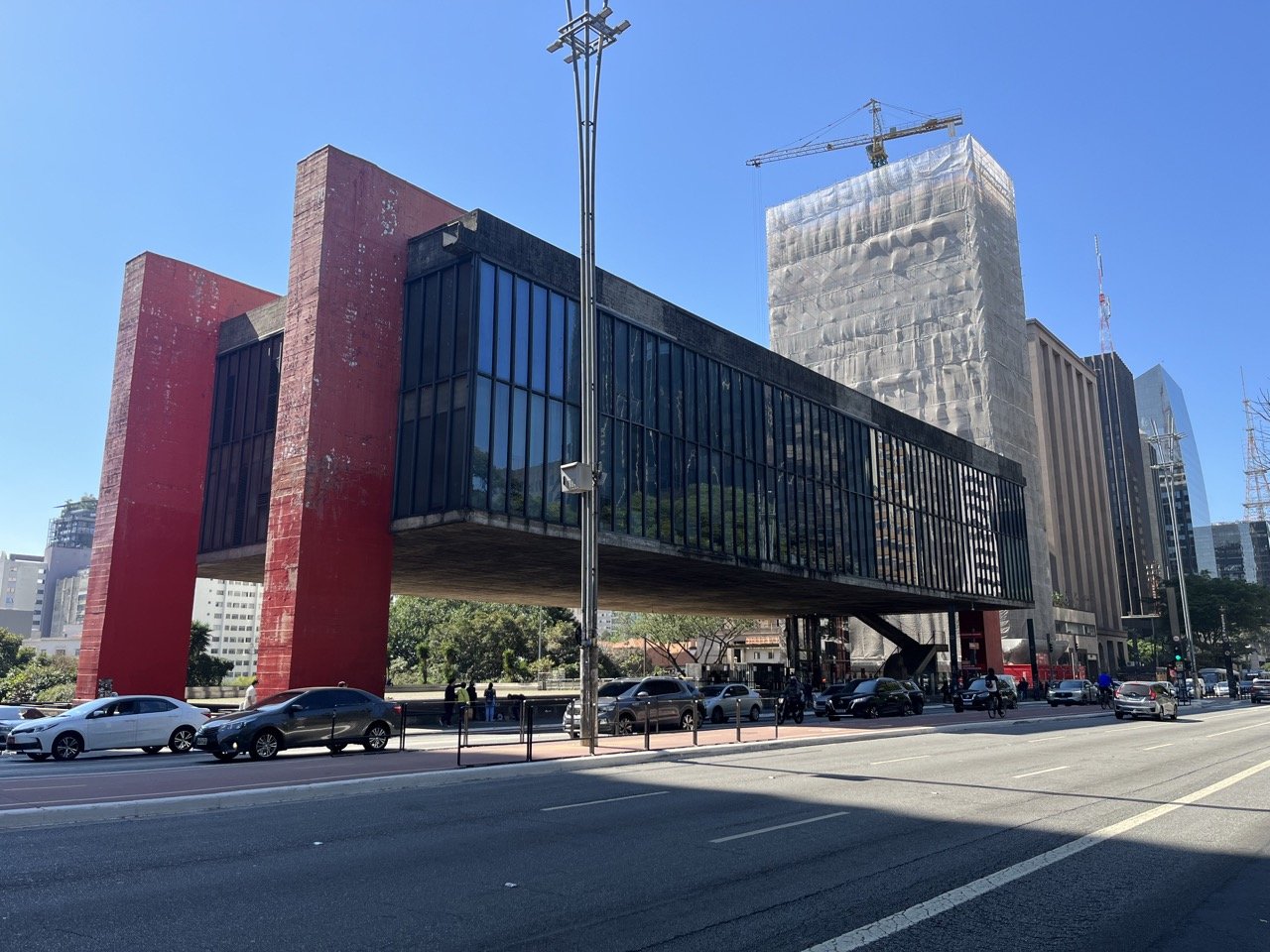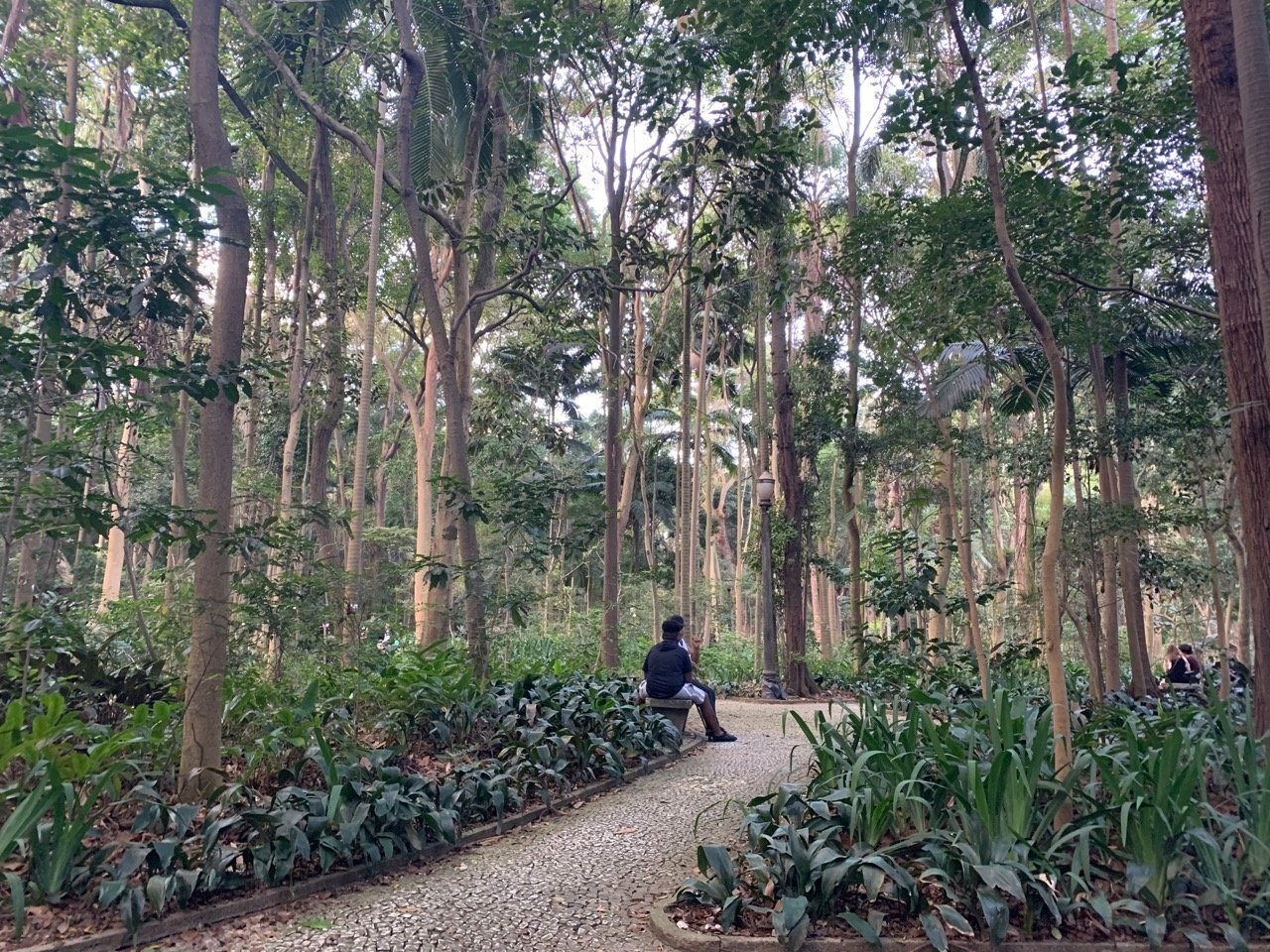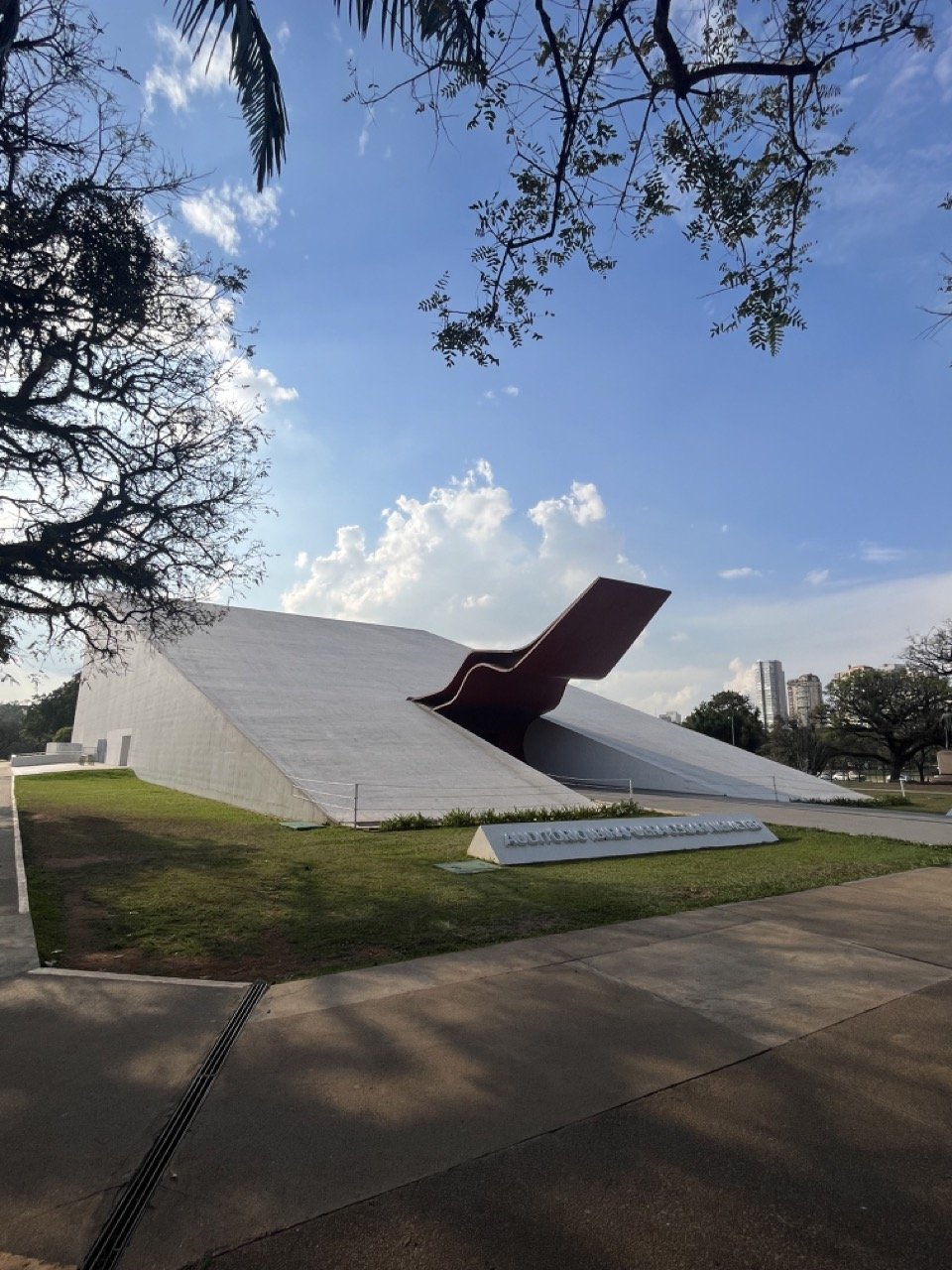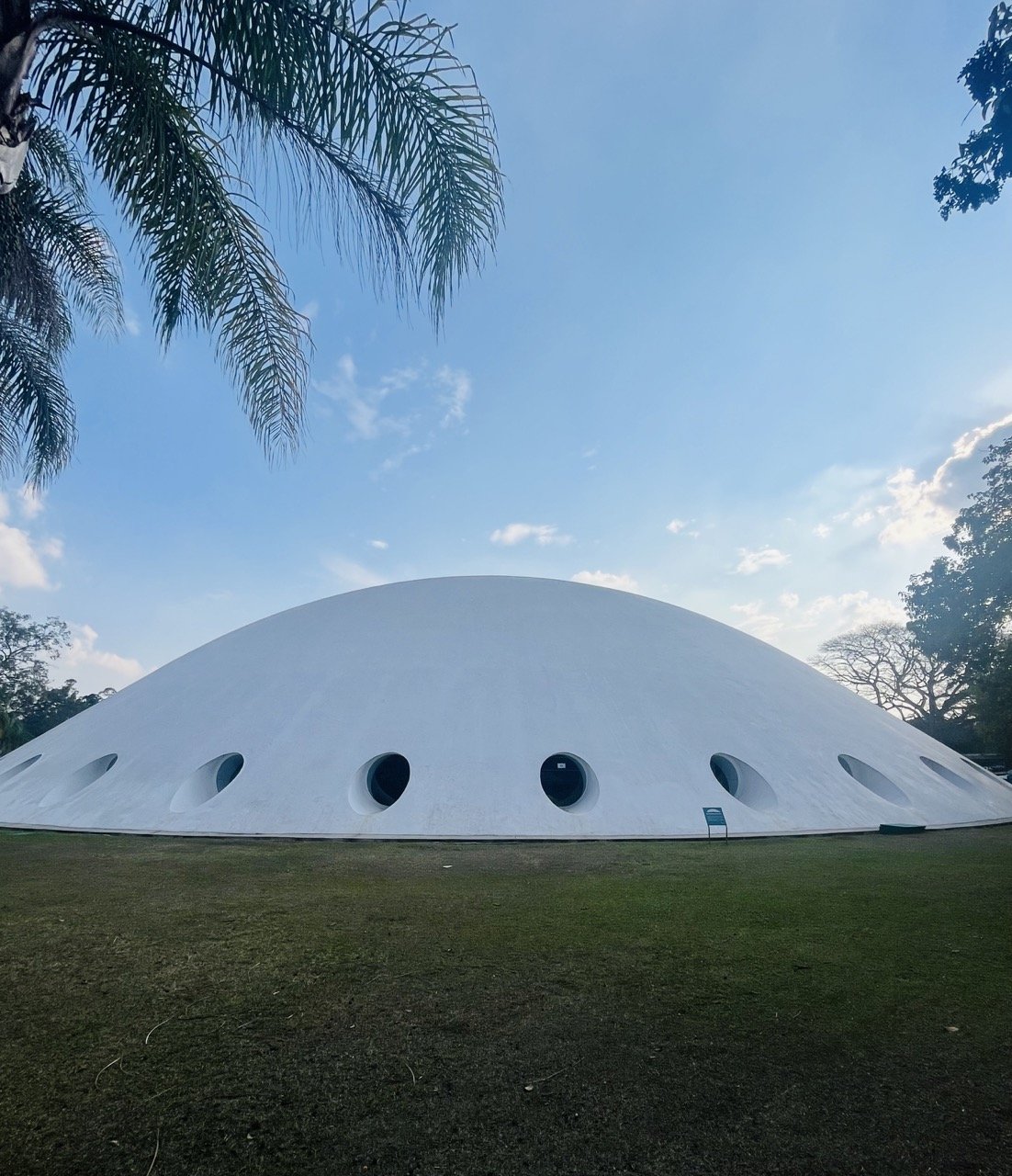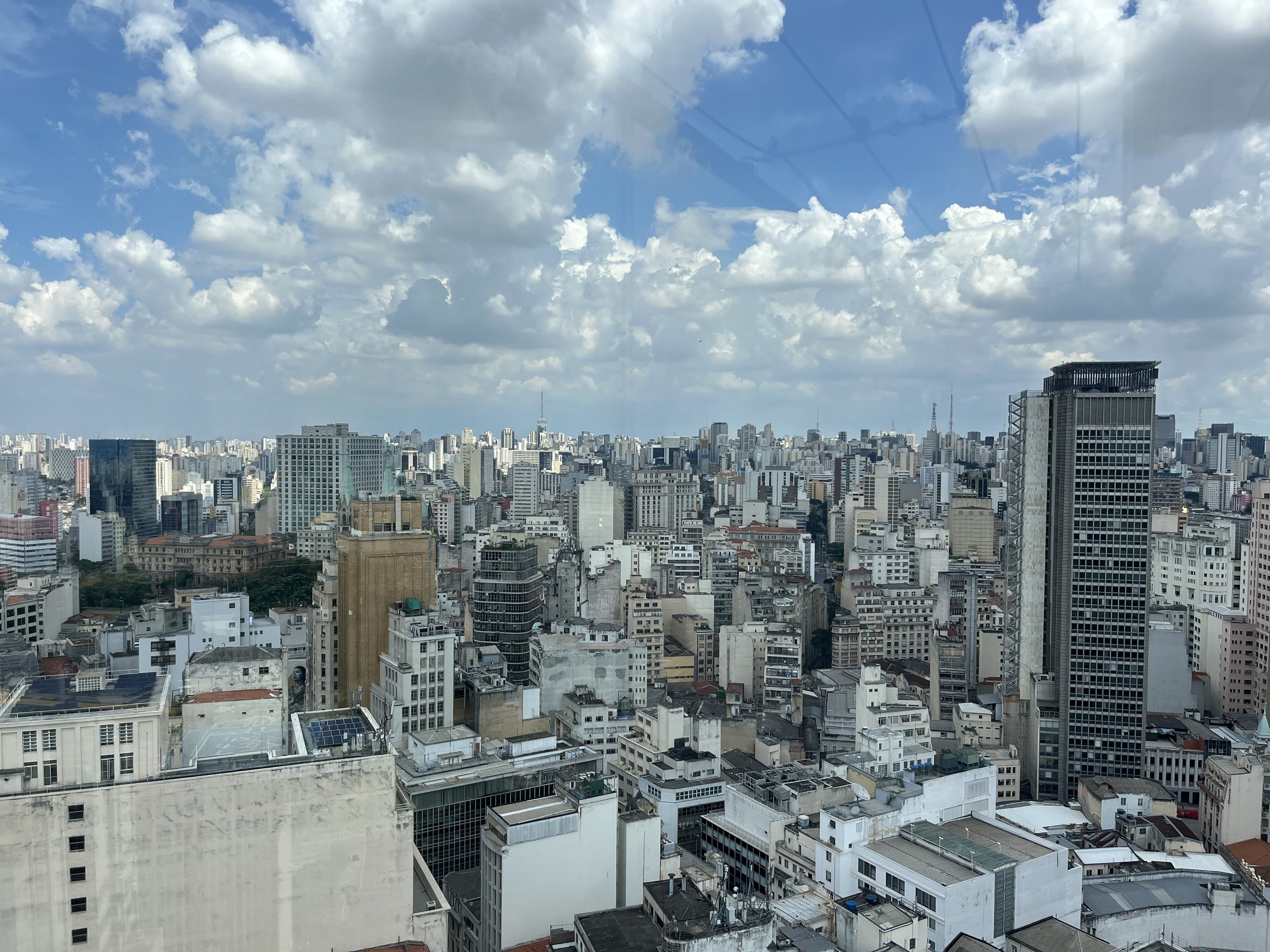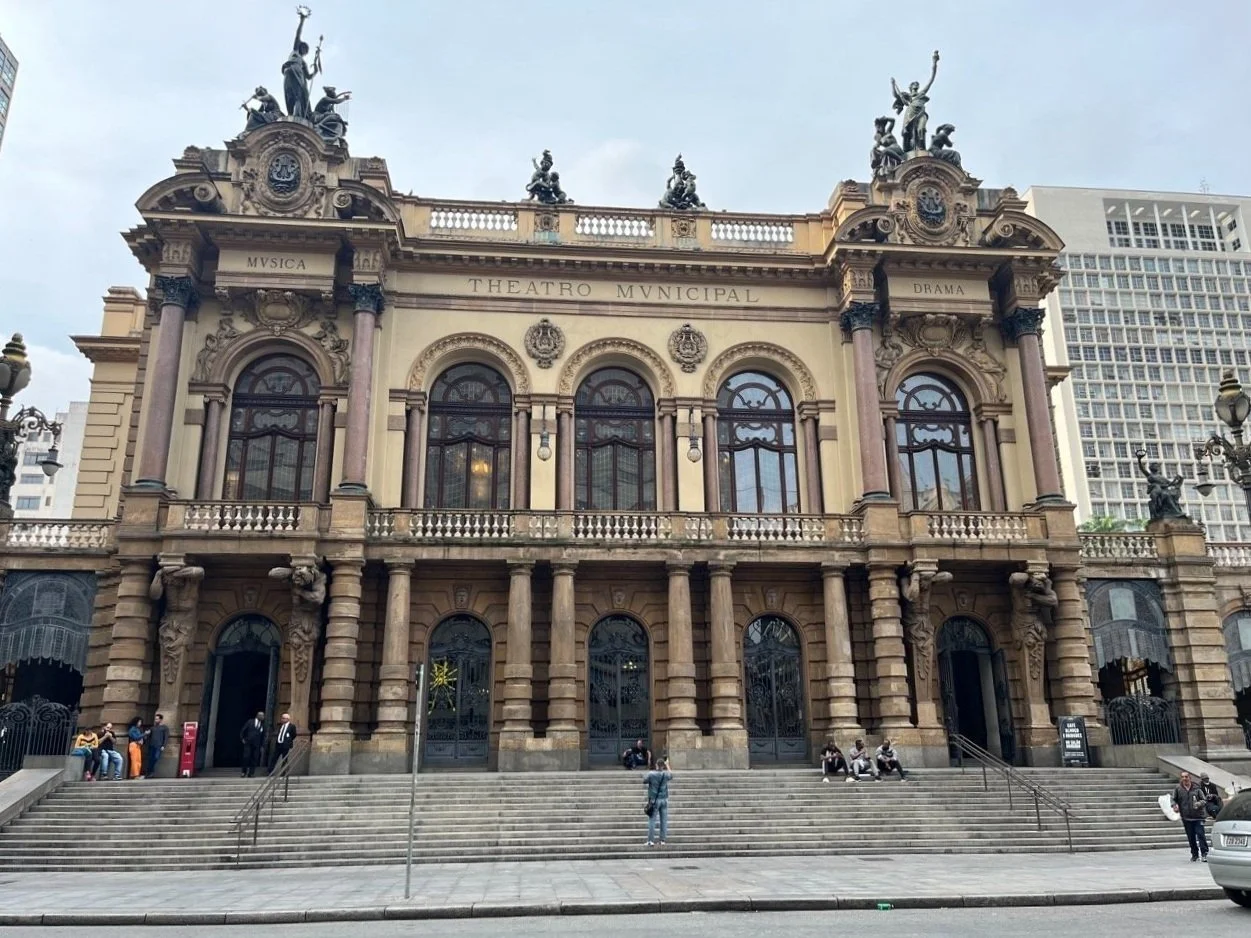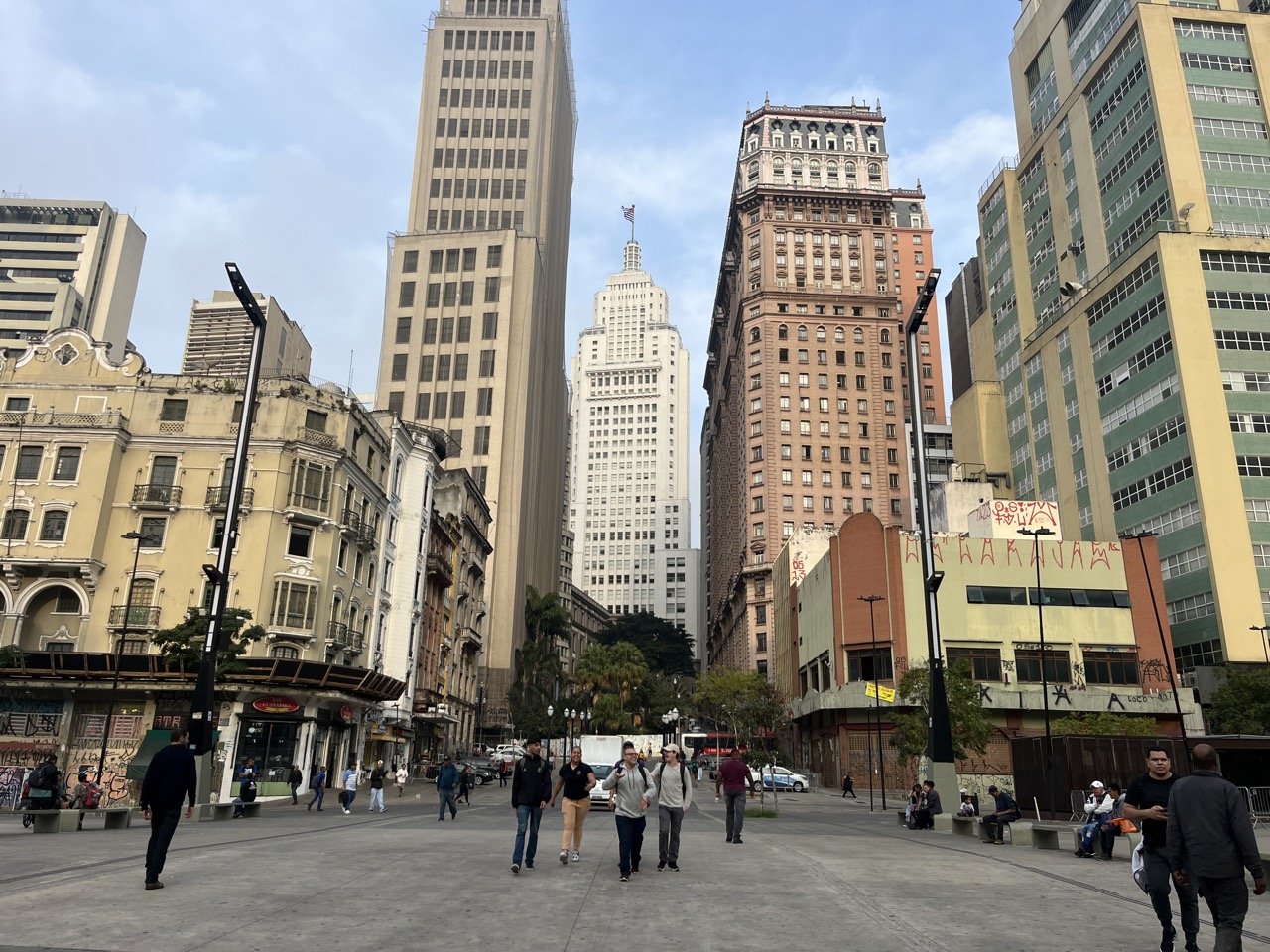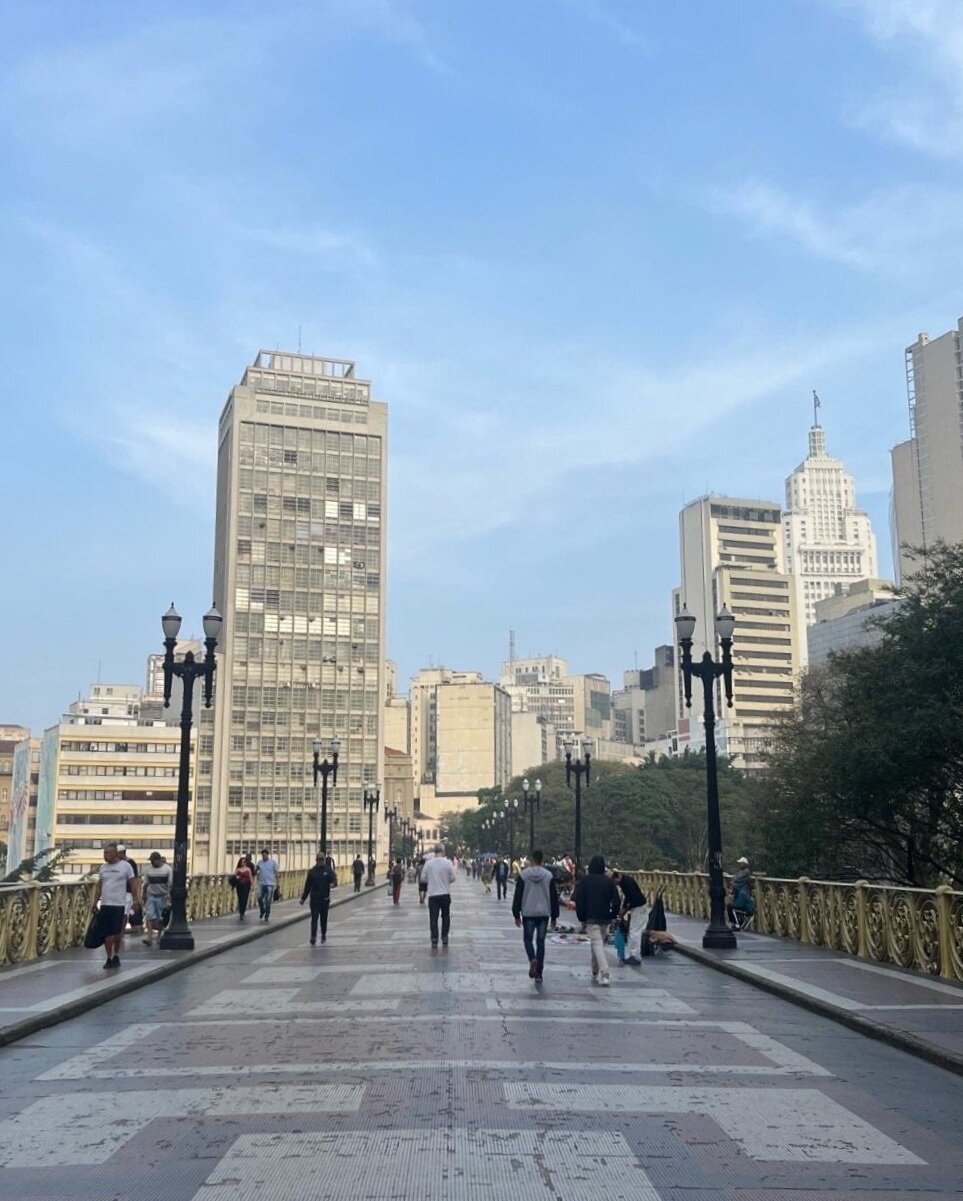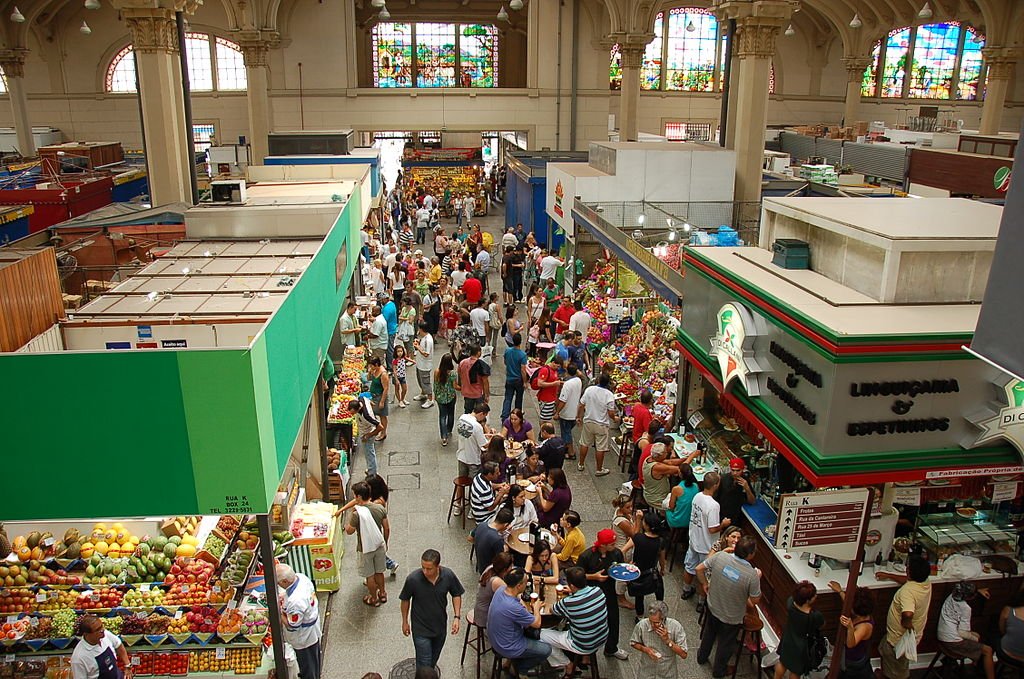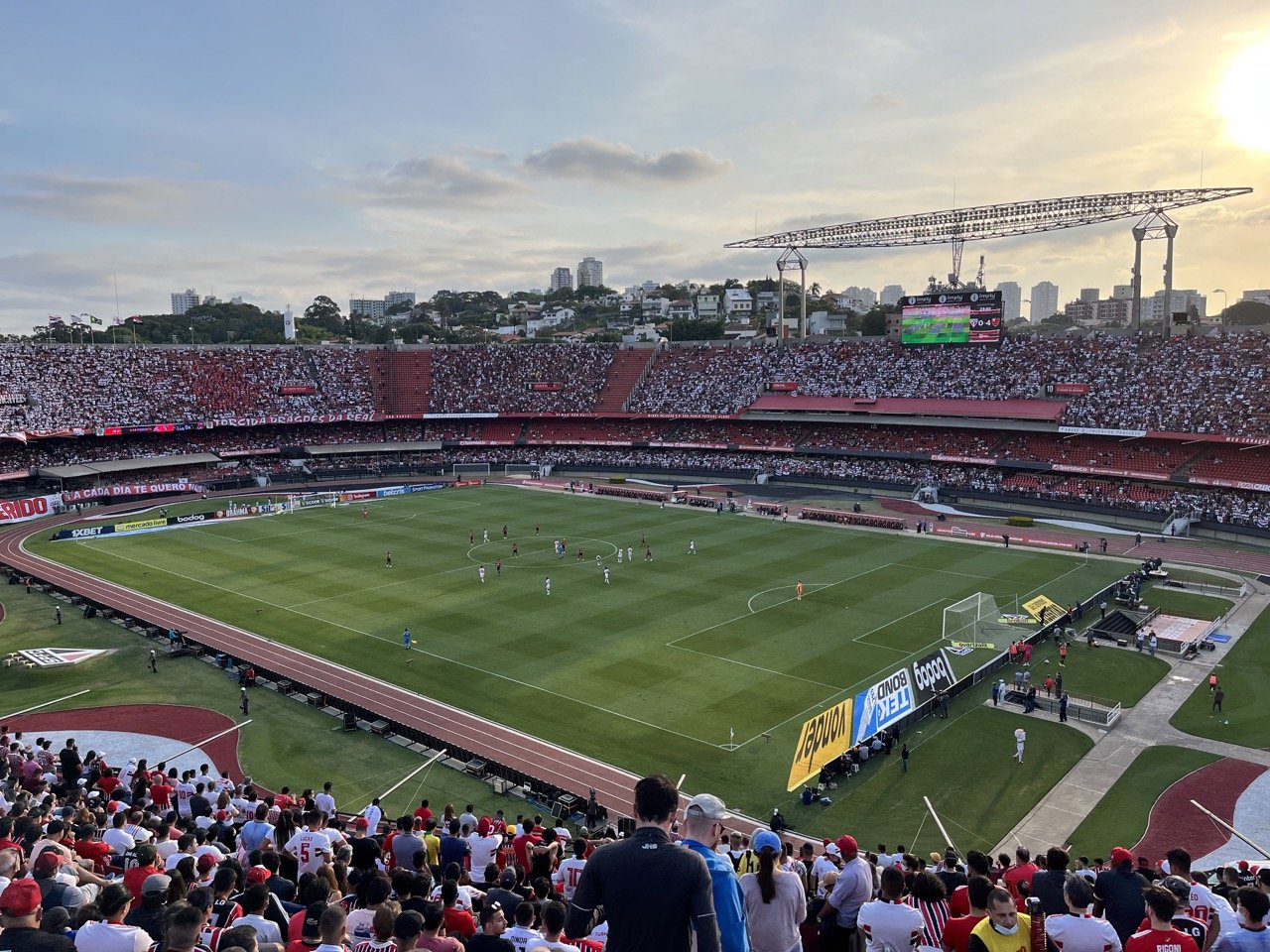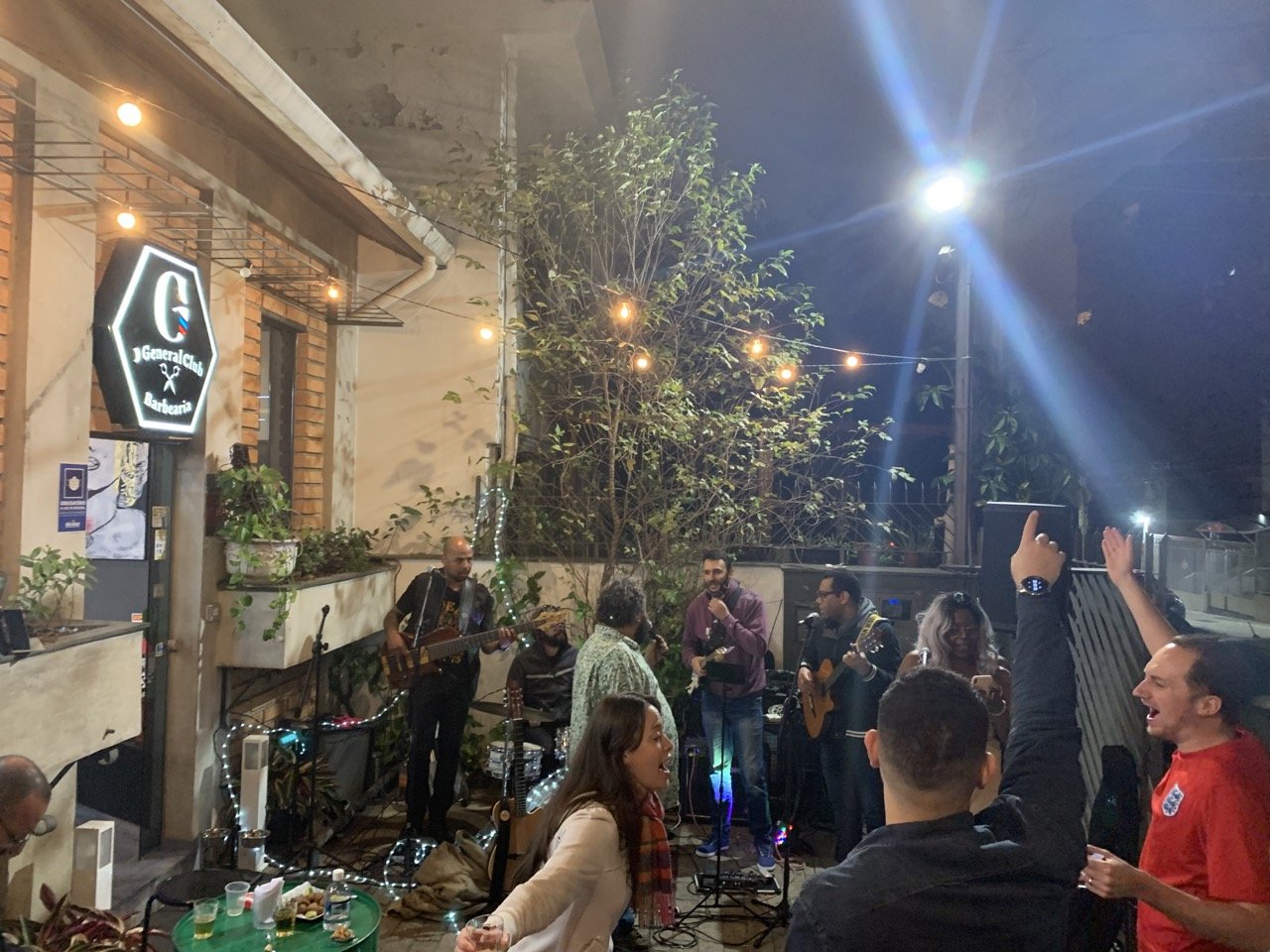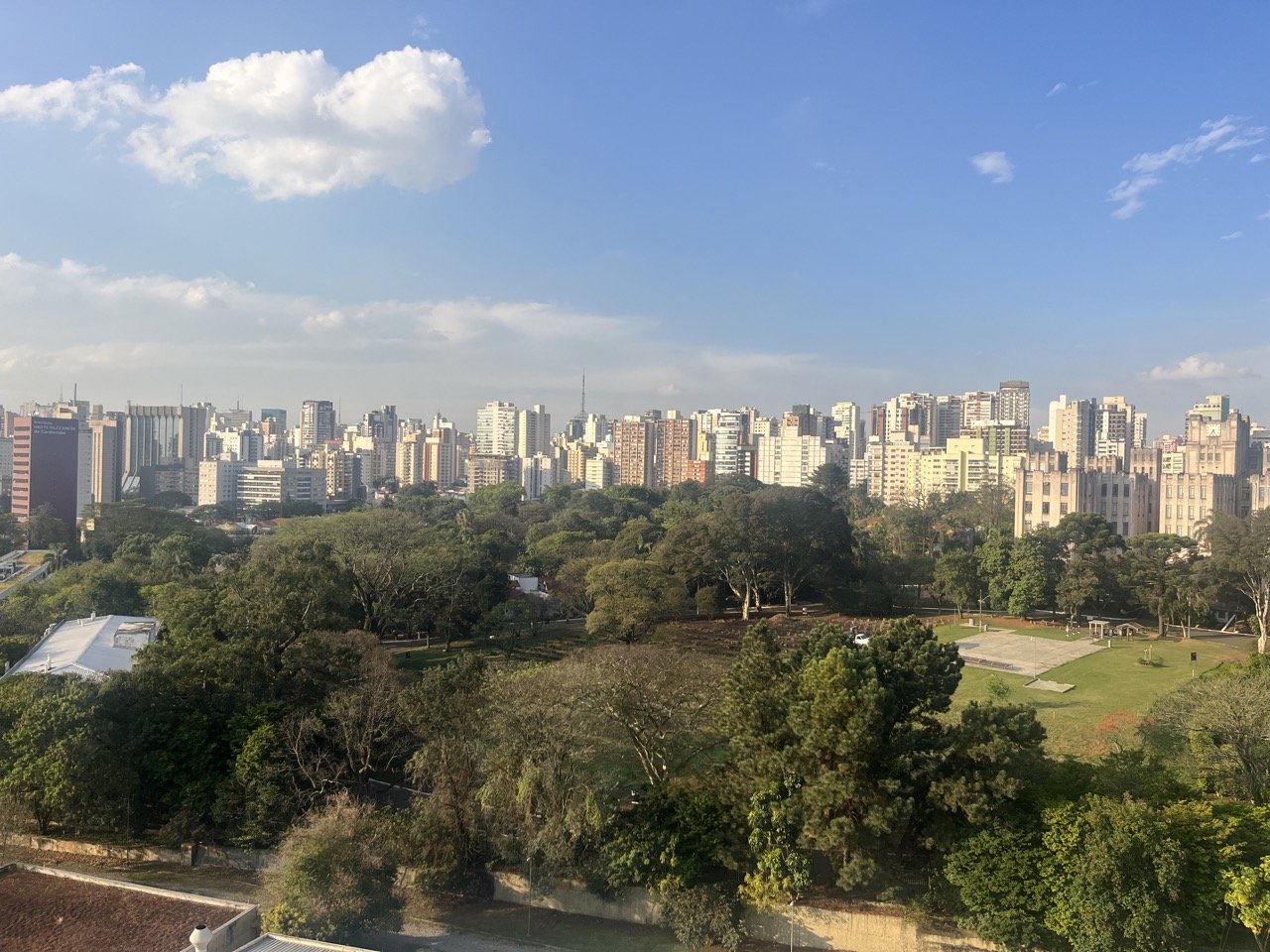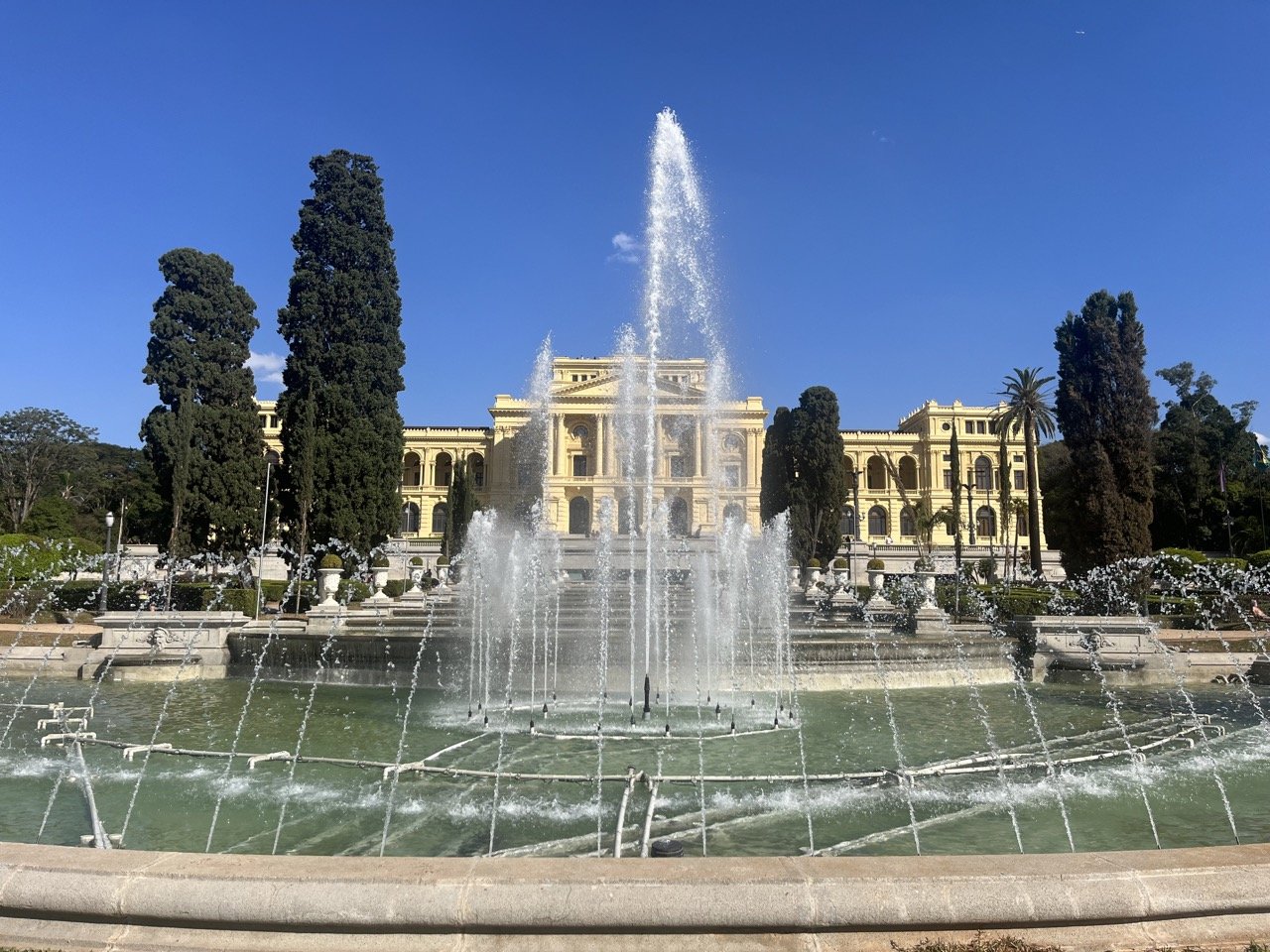30 Things to Do in São Paulo, Brazil - By a Local
Affiliate disclosure: some of the links in this article are affiliate links. If you book using one of them, we’ll earn a small commission. All of our info is free to read and free of ads, so we appreciate it!
Avenida Paulista on a sunny day, seen from SESC Paulista’s rooftop
Brazil is a complex country; continent-sized, and with a racial, ethnic, economic, geographic, and ecological diversity that is mind-boggling. And São Paulo is Brazil in miniature. Though not that miniature, considering the city has 12 million inhabitants and 20 million in the greater urban area. São Paulo alone is bigger than many medium-sized countries.
While there are many cities where you can hop off the airplane, head to the city center, and basically just wander around checking off all the big sights as you go, São Paulo is not one of them. But that isn’t to say there’s nothing to see. It just takes some effort. And maybe a little local help. That’s why I’m here!
The following list of 30 of the best things to see and do here is a good introduction to São Paulo’s attractions, but it is by no means exhaustive. I’ve tried to include a host of my favorite sights and activities without overwhelming you with a never-ending list.
I’d recommend browsing through this guide, selecting what interests you, and then plotting it all on Google Maps so that you can see how to best arrange your days.
For even more info on the city, check out my other guides:
Table of Contents
São Paulo planning cheatsheet
 Plan your itinerary with expert advice
Plan your itinerary with expert advice
- Book a Brazil travel consultation with a local expert
 My favorite hotels in São Paulo
My favorite hotels in São Paulo
- Hotel Emiliano - always my #1 choice for true luxury in Jardins. $500/night
- L'Hotel PortoBay - upscale and elegant in Bela Vista. $300/night
- Qoya Curio by Hilton - very nice mid-range hotel in Paraíso. $200/night
- Radisson Pinheiros - new and modern hotel in the heart of Pinheiros. $170/night
- Laghetto Stilo - great value on a quiet Paraíso block. $120/night
 Guided tours and activities
Guided tours and activities
 How to get around
How to get around
- Car rentals with DiscoverCars
- Urban metro & bus routes from Moovit
- Long distance buses via 1001 and Águia Branca
Meet the author
Renato, the author of this guide (and all of our São Paulo articles), is a journalist and local tour guide. He's been showing visitors around his city and region for over a decade.
In addition to writing these great guides and itineraries, he also offers really interesting private tours of São Paulo. If you want to see “Sampa” with a local's perspective, check him out!
1. Walk down Avenida Paulista
Avenida Paulista on a busy Sunday
Japan House's cool bamboo exterior
The view from SESC Paulista's rooftop
Casa das Rosas
The city’s main thoroughfare and home to the old financial district before most of the banks moved to the Faria Lima and Itaim Bibi area. The avenue, just Paulista for short, is best visited on a Sunday when it is pedestrianized and closed to traffic (beginning at 8:00 am).
Paulistanos sometimes affectionately call Avenida Paulista “a praia Paulistana” or São Paulo’s beach due to Sunday activities resembling those more commonly seen on Rio de Janeiro’s seaside Avenida Atlantica.
Aside from lots of neat architecture, there are also a host of interesting sights and cultural institutions worth stopping at.
Here are a few places not to miss:
Casa das Rosas - The last 20th century mansion that remains on Paulista. It's free to enter and has a pleasant rose garden.
SESC Paulista - A cultural center with a terrific (free) rooftop viewpoint. They also have free phone charging lockers if you're running low on juice!
Japan House - Free art museum dedicated to Japanese art/artists. The exhibits are always interesting, unusual, and fun. Great cafe and restaurant too.
Parque Trianon - One of the best parks in the city.
MASP - São Paulo's most famous art museum.
IMS Paulista - A museum and cultural space with 3 floors of rotating exhibits, largely focused on visual art/photography.
2. See the collection at MASP
MASP museum
Hands down São Paulo’s most famous piece of architecture and it’s most celebrated museum, officially called the Museu de Arte de São Paulo (São Paulo Museum of Art), you will only ever hear Paulista's refer to it as MASP (pronounced MAH-SPEE). It is a glass and concrete behemoth designed by famed Brazilian architect Lina Bo Bardi that houses a huge collection of over 8,000 pieces of art.
The main draw is its collection of European modern art (the largest of any museum in the Southern hemisphere), but you’ll also find excellently curated exhibits of Asian, African, and American art.
Check their website for a list of temporary exhibits, guest lectures, and all sorts of interesting programming - https://masp.org.br/en. Entrance costs 70 BRL.
3. Experience an urban jungle at Trianon park
Parque Trianon
Trianon Park is directly across from the MASP museum, so makes perfect sense to combine with a visit to the museum and a walk on Avenida Paulista.
It's one of my favorite parks in the city because, instead of being a big open space, it's a densely forested, jungle-like park that has a serious of pretty cobbled walking paths running all throughout it.
It's the perfect place to go for a little peace after an (over)stimulating walk along crazy Avenida Paulista.
4. Relax in Ibirapuera Park
Sao Paulo’s skyline seen from within Ibirapuera park
Auditorio Ibirapuera
Oca building
Ibirapuera is the city's green lung and a much-needed respite from the endless concrete around you. If you want to avoid the crowds, come in mid morning or the early afternoon.
To catch a glimpse of how Paulistanos relax, stop by before dinner and watch all the gente bonita (beautiful people) jogging, biking, roller blading, skateboarding, picnicking, and mingling.
The park also houses a number of museums - the Museu Afro Brasil and Museum of Modern Art (MAM) - and iconic pieces of architecture by famed Brazilian architect Oscar Niemeyer, including the Auditório Ibirapuera and Oca building.
5. Catch some city views at Banespa/Farol Santander
The view from Farol Santander
Officially called the “Edificio Altino Arantes”, but better known as the Banespa building due to having housed the old Banespa bank, this is an art deco skyscraper inspired by New York’s Empire State Building.
The top few floors of the tower now house the Farol Santander museum, which has a collection of art exhibits (of pretty varying degrees of quality).
At the 26th floor of the "museum” is a terrific rooftop viewpoint that affords jaw dropping views of São Paulo’s endless city scape.
Buy tickets and learn more on the official site here.


6. Explore Liberdade, São Paulo’s Little Tokyo
A Liberdade street during the weekend Feira
São Paulo’s “Little Japan” is one of the first stops on most tourists itineraries, and with good reason. The neighborhood is adjacent to the historic downtown and has countless Japanese eateries and stores. You have Izakayas serving Japanese bar food, Ramen houses with just one item on the menu, and dozens of mid to high end sushi bars.
You can also peruse countless shops, markets, and street vendors selling everything from Japanese groceries to crafts, manga comics, and cheap electronics.
While this is the historic Japanese neighborhood and plenty of restaurants and Japanese stores remain, many of the immigrants and their descendants have moved on to other neighborhoods. You’ll still find plenty of people of Japanese heritage, but now you’ll also see other Brazilian residents and more recent immigrants from China, Africa, and Latin America.
To see Liberdade at it’s busiest, visit in the mid morning to early afternoon on Saturdays and Sundays when the Feira da Liberdade (Liberdade street fair) is in full swing and Paulistanos from all over the city come to wander, eat, and shop. Be prepared for serious crowds as this event has gotten more popular than ever.
For a classic meal, go have gyoza and lamen (in Portuguese it's lamen, not ramen) at Aska Lamen, the best ramen joint in SP.
While here, also check out the Jardim Oriental (oriental garden) and the Museu da Imigração Japonesa (Museum of Japanese Immigration).
*If you want to see Liberdade and also cover all of the city center’s highlights in a morning or afternoon, check out my city center walking tour or my city center bike tour.
7. Admire the neo-Gothic Catedral da Sé cathedral
Catedral da Sé
The city’s iconic and beautiful neo-Gothic Sé Cathedral. Standing in the middle of the palm tree-lined walk and gazing up at the enormous green dome and soaring twin spires is a must on any São Paulo to-do list.
The city has recently cleaned up the square and some of the surrounding area, so visiting now is much more pleasant than in past years. Police are also omnipresent around the square.
8. Marvel at the ceiling and stained glass at Mosteiro São Bento monastery
São Bento Monastery
São Bento monastery is one of São Paulo’s oldest churches, dating back to 1598. While the façade is much more modern and little (if anything) remains from Colonial days, the monastery is still a visual feast.
The beautiful carved ceiling and impressive stained glass windows make it a worthwhile stop on any visit to the city’s downtown. The church bakery also sells tasty treats made by the monks themselves following centuries-old recipes.
For something totally different, on the second and final Sunday of each month the monastery offers an all-inclusive brunch, featuring all sorts of dishes by renowned local chefs. If interested, check out the monastery website and send them an email to reserve your spot!
9. Eat a “sanduiche de pernil” sandwich at Estadão
A “sanduiche de pernil” at Estadão
Most visitors to São Paulo visit the municipal market and try the classic mortadela sandwich. That’s well and good and you should too, but if you want something less touristy and a whole lot more local, head to the city’s most famous “diner” for a pernil sandwich.
Estadão is a little restaurant located on a busy intersection in downtown SP. Open since 1968, this 24-hour spot serves up counter snacks, hearty meals, and the city’s best sandwich - um sanduiche de pernil. Pernil is slow roasted pork, and it’s served on a crispy roll accompanied by onions, green pepper, and, if you want it, cheese and a nice slice of pineapple.
One of the most special things about Estadão is that you’ll find people from every walk of life here, all seated at the same counter.
This is an absolute must for a classic São Paulo meal.
10. See a show (or take a tour) at Theatro Municipal
Theatro Municipal
Sao Paulo’s municipal theater is a gorgeous structure which mixes styles from art nouveau to baroque. While you have the option of guides tours (free), the best way to see the theater by attending an opera or symphony performance! Check the theater's website for their event calendar.
If you're interested in a free tour, here's the schedule:
In Portuguese
Tuesdays at 10:00 am, 11:00 am and 5:00
Wednesdays, Thursdays, and Fridays at 11:00 am, 1:00 pm, 3:00 pm, and 5:00 pm
In English
Saturdays at 11:00 am
Wednesdays, Thursdays, and Fridays at 1:00 pm
11. People watch in the Vale do Anhangabaú
Vale do Anhangabaú
The Banespa building seen from Vale do Anhangabaú
Viaduto Santa Ifigênia
The Anhangabau “valley” is an enormous square located in the heart of the city center. It was completely reopened in 2022 after an extensive (and controversial) renovation and is now an enormous open public space.
It's a favorite spot for meeting up with friends, rollerblading, skateboarding, and just sitting, reading, and contemplating. It's also great for people watching.
The city frequently puts on free live events here (concerts, shows, etc.) and it's right in between the Banespa building and the municipal theater, so you won't have to go out of your way to visit.
Nearby, you also have two lovely pedestrian bridges that are worth walking over: Viaduto do Cha and Viaduto Santa Ifigenia. They're iconic and offer great vantage points for photos.
12. See serious local commerce on on Rua 25 de Março
A winter day on Rua Ladeira do Porto Geral leading down to Rua 25 de Março. Photo: C.araujo26, CC BY-SA 4.0, via Wikimedia Commons
This is one of São Paulo's most famous streets. You could ask any resident what it is and they'd immediately know what you're talking about.
Located right in the city center, Rua Vinte e Cinco de Março was once of the city's main shopping streets. Wealthy residents have long stopped coming here, but it remains a center of commerce for many Paulistanos and practically anyone who lives in the area.
The entire street is lined with store after store selling every type of good you can imagine and street vendors hawking their wares. Shoppers always crowd the street and the stores, making for a very interesting (and at times chaotic) atmosphere.
Because it's on a street behind the the Farol Santander/Banespa building, it's easy to visit when sightseeing there. To get there, make your way down the the steep Rua Ladeira do Porto Geral street and then prepare to watch as your route morphs into an explosion of color, commerce, jostling shoppers, shouting vendors and touts, and wares overflowing every corner of the street.
Cosmetic stores, bootleg CDs and USB drives, kitchen supplies, textiles, knock off clothing, religious supplies, cell phone repair stores, cheap jewelry, opticians, party supplies… If there’s something you want to buy, someone on 25 de Março is selling it!
Police presence along the street is always pretty good, but pickpocketing and petty theft can happen here, so watch your things careful and leave your phone in your pocket. While the street is safe, the area around it is not the best, so don't go wandering down side streets.
13. Have a look around the Mercado Municipal (Mercadão)
Photo: Felix Tansil, CC BY-SA 3.0, via Wikimedia Commons
Affectionately known as the Mercadão (big market), São Paulo’s famous municipal market is home to hundreds of vendors selling everything from dried codfish to exotic fruits from the Amazon and all over Brazil. This is just a few minutes walk from 25 de Março street, so combines nicely with a stroll there.
It’s most famous dish is hands down a sanduiche de mortadela (mortadela sandwich) for which each vendors seem to be trying to one up the other in size and quantity of meat. If this doesn’t sound appealing, try a pastel de bacalao (codfish empanada) or just sample (for free!) any fruit that catches your eye.
The market has gradually become more of a tourist attraction than a genuine market and prices here are very inflated, so save your shopping for later. I haven’t experienced this, but to avoid vendors asking you to pay for samples, just try one or two things per vendor.
And as I mentioned with Rua 25 de Março, don't go wandering around the area.
14. Learn about São Paulo’s early history at Pátio do Colégio
Located in the heart of the city center, this is one of the few remaining colonial buildings and is a church and school where Jesuit priests officially founded the city of São Paulo in 1554.
You can go inside the courtyard of the building for free. Inside is a section of one of the original walls of the building, which is neat to see. The rest of the building is a (paid) museum with a cool collection of maps and images that show how the city has grown and expanded over time.
Police presence here is always substantial and it's totally safe to visit, but homelessness in the area is very high, so just know that.
15. Grab a drink at the Terraço Italia rooftop bar and restaurant
Edificio Italia
This rooftop bar and restaurant is located inside the famous “Edificio Italia” building, in the República section of downtown São Paulo. The skyscraper, one of São Paulo’s largest (the 4th tallest to be precise), is 46 stories tall, boasts a whopping 19 elevators, and has a great viewpoint as well as a very fancy restaurant.
You can visit the 42nd floor viewpoint from 3:00-7:00 pm Monday to Friday for 50 BRL. Visits are free from 3-4 pm daily, but advance booking is required. Take that information with a very large grain of salt - I cannot tell you how many times I've been to visit the viewpoint and been told "sorry those hours aren't correct anymore". No one ever seems to know when it's open, so it can be a bit hit or miss.
If you aren't able to visit the viewpoint, there's another way to get the same view. You can head straight to the “Terraço Italia” restaurant located on the building's 41st floor. The restaurant is open to the public and you can enjoy the view for the price of a cocktail or beer.
If you want a fancy meal, you can also do a set price dinner and watch the city light up all around you as you eat.
Bear in mind that men must wear pants and shirts with sleeves, or they will be denied entry.

From the Art Deco skyscrapers of the city center to the leafy streets of Vila Madalena, crisscross the city on tour with local guide Renato!
16. Walk, bike, or just chill on the Minhocão elevated highway
People walking on the Minhocão. Photo: Virada Sustentável, CC BY-SA 2.0, via Wikimedia Commons
Street art along the Minhocão
More Minhocão
Literally translated as “Big Worm”, the Minhocão is an elevated highway that is now regarded as an urban planning disaster. It runs smack through downtown, almost touching the apartment buildings it passes, and totally cuts off a series of neighborhoods from each other, partially separating the city.
The attraction here is that from 8:00 pm until 7:00 am during the week (and all day on the weekends) the highway is totally closed to traffic and is reclaimed by residents to relax, exercise, have a beer, and congregate.
Gargantuan murals, many with social themes and critiques, have been painted on the facade of once drab concrete apartment buildings all along the highway’s path, creating a beautiful and thought provoking outdoor museum.
At nighttime, sometimes you can even catch open air movie screenings.
17. Explore Bom Retiro, São Paulo’s Koreatown
Korean bbq at New Shin La Kwan restaurant in Bom Retiro
A Korean restaurant
A commercial street
Sumo wrestlers practicing at a gym in Bom Retiro
Initially a hub of Jewish life in São Paulo, the Bom Retiro neighborhood (next to downtown) started to receive an influx of Korean immigrants beginning in the 1960s. That immigration has continued to modern day, completely changing the neighborhood.
A major center of Brazilian textile production (run mostly by Koreans), Bom Retiro's commercial streets are lined with little clothing factories and stores selling fabrics, wedding dresses, sewing machines, and all sorts of clothing.
On less commercial streets, the neighborhood boasts dozens of Korean restaurants, cafes, and bars ranging from Korean bbq to shaved ice and even karaoke. There's even a brand new shopping mall called “K-Square”.
This is one of my favorite neighborhoods in the city to explore. In some ways, it's similar to what Liberdade used to be like before the Japanese immigrants integrated into Brazilian society and moved on to other areas. This is very much an actively inhabited (and growing) Korean neighborhood. There's cool street art all around, it looks different to anywhere else in the city, and there are all sorts of hidden alleys, secret little corners, and unexpected finds (like a sumo wrestling gym and a baseball stadium!).
If you’re here over the weekend, the weekly “Feira do Bom Retiro” street fair/market, held every Saturday from 10:00 am to 5:00 pm, is a great time to visit. You’ll find street vendors selling Korean products (and regular produce), pop up restaurants, food trucks, local artisans, and, often, K-pop music events. The neighborhood is not just Koreans though, and you’ll also get to browse stalls that reflect the Bolivian, Paraguayan, and Peruvian communities that are present in and around the neighborhood. Check out the fair’s official instagram to know what’s on for each week.
Bom Retiro, while somewhat an oasis of safety in the day time, is adjacent to the neighborhoods of Luz, Santa Ifigenia, and Campos Eliseos, all three of which have a lot of homelessness, people suffering from drug addiction, and petty crime. So, it's best to get there by taxi/Uber and to keep your wits about you, stick to the busy streets, and don't wander at night.
18. Wander the Pinheiros neighborhood
A view over Pinheiros and the Benedito Calixto flea market
Pinheiros used to be a quiet, working class neighborhood with many warehouses and stores for vendors selling things like furniture, home goods, and other “functional” things. While some of that still exists, the neighborhood has undergone various waves of gentrification and is now one of the wealthiest and hippest neighborhoods in the city.
Pinheiros is now home to hipster bars, trendy restaurants and cafes, and high end condominiums. Many of the city’s best design studios are located here along with loads of small art galleries, boutiques, and endless shopping options.
This is one of very few neighborhoods in São Paulo that feels genuinely walkable and it’s a pleasant place to wander around, stopping to pop into myriad spaces that interest you and catch your attention.
The iconic Tomie Ohtake Institute is here, with an enormous space dedicated to exhibitions on design, architecture, and contemporary art.
Another Pinheiros favorite is the Benedito Calixto fair/flea market that takes place every saturday from 9:00 am to 5:00 pm in the Praça Benedito Calixto square. This fair has been going strong since 1987 and is a cultural reference point for the city, much beloved by musicians, intellectuals, thrifters, antique fans, and just about everyone else!
If you’d like to explore with a guide, I offer a Vila Madalena & Pinheiros walking tour. I also do bike tours which are able to cover even more ground and include a visit to Ibirapuera park.
19. Go on a Street Art Tour
Street art decorating an overpass in the city's North Zone
or years the city government and traditional street muralists, taggers, and pixadores (the artists who write in the black gothic script all over buildings) were locked in a never ending battle. In one notorious case, the city government even went so far as to spend millions of dollars on hanging gardens they installed to cover a several mile stretch of murals along a central highway.
Finally, coinciding with the international recognition garnered by local muralists like Eduardo Kobra, the city seems to have recognized the value of these projects, both large and small, and now even commissions artists to do them.
Most tourists just head straight to Beco do Batman in Vila Madalena, and call it a day for street art. This is a real shame. The city center, Bom Retiro, and a few other neighborhoods are overflowing with fabulous murals, many with sharp social critiques, and exploring these areas is well worth the effort.
To fully understand the context and to visit efficiently, you really need a guide.
If you’re interested in street art, I run two tours in the city that focus on urban art and graffiti:
On my private Green City + Street Art Tour we combine some more general sightseeing with a bike ride though Ibirapuera park and then riding and street art viewing in in the neighborhoods of Pinheiros and Vila Madalena
20. Catch a soccer game
A full house at Sao Paulo FC’s Estadio do Morumbi stadium
Brazil’s fabulous “Seleção” (national soccer team) long ago put Brazil on the map as probably the most soccer-mad country on earth.
In São Paulo, rivalries run deep and span generations. The three biggest teams are Palmeiras, Corinthians, and São Paulo. Corinthians play deep in the working class Zona Leste (East side of the city) at the Arena Corinthians, while Palmeiras is based in the upscale Pompeia neighborhood at the glitzy Allianz Parque, and São Paulo plays in the leafy, wealthy neighborhood of Morumbi. We must also mention Santos FC who, though actually from the port city of Santos an hour away, also have a huge fan base in the city.
If going just for the atmosphere, Palmeiras have an excellent stadium reachable with public transport and an area of bars and restaurants circling the grounds. To see the teams’ support at their most lively, try to catch an inter-city derby between any of the three teams.
If you want a really local experience, two Paulistano teams that play in lower devisions, but still have intensely dedicated fan bases are Portuguesa and Juventus. Our favorite is Juventus - with a rockin’ but always friendly and intimate atmosphere, games are held at their stadium in the traditionally Italian neighborhood of Mooca, just east of the city center.
My pro-tip for after a game is to pick one of the countless bars or traditional Italian cantinas and hang out for dinner and drinks. Do a little research first though as some of them are duds. Our favorite, Cozinha dos Ferrari, is neither traditional nor open for dinner. But its worth the trek for a surprisingly good weekday lunch in a surprisingly unassuming atmosphere.
Wednesday is the typical soccer night, though there are also weekend games. If you don’t want to make the trek to a stadium but are interested in still soaking up the soccer atmosphere, just pull up a chair in any bar, cafe, or restaurant and start chatting with your neighbors.
A particularly good place to watch a game with a crowd is in the Santa Cecilía neighborhood in Largo de Santa Cecília, an open air square ringed with cheap bars which always show the games. Vila Madalena, Itaim Bibi, and Bela Vista also make good options.
21. Listen to live music (and make it Samba!)
In São Paulo your only problem with finding a live music event that interests you will be deciding on any given night which of the dozens of fantastic options you want to choose! One of my favorites is actually a Saturday afternoon event.
Head to the Mooca neighborhood east of the city center to Templo - Bar da Fé to enjoy some of the area’s best Samba along with great bar snacks and excellently prepared feijoada, Brazil’s national dish.
If you want to check out your options, the online magazines Catraca Livre and Guia da Semana as well as the newspaper Folha de São Paulo all have day-by-day listings for music shows, cultural events, and much more (many of them free)!
22. Hang (and party) with the locals in Praça Roosevelt
Skateboarders in Praça Roosevelt on a grey afternoon (before the party!)
Roosevelt Sq. is a large open space at the border between the Consolação neighborhood and downtown.
In the day time it’s mostly skateboarders, parkour enthusiasts, and Tik Tok dance troups, but by night it transforms into a hangout point for hundreds. The square is ringed by bars, some more interesting than others, and is lively from late evening through the early hours of the morning.
The crowd is mostly people in their mid 20s through early 30s and leans leftist and somewhat alternative. If this sounds up your alley and you want to mingle with a diverse crowd of Paulistas, a good idea is to grab a couple of beers from a nearby convenience store and hang out for an hour or so before moving on to enjoy the countless nightlife options south in Consolação or north in the República neighborhood.
23. Enjoy the view at the MAC Museum
View from MAC rooftop
Another view from the rooftop
An exhibit at the MAC
For contemporary art enthusiasts, the MAC USP (Museum of Contemporary Art) is your São Paulo mecca. Spread out over 5 floors and located just outside Ibirapuera park in the Vila Mariana neighborhood, the museum hosts a dizzying array of artwork from both Brazilian and international artists.
As an added bonus, the rooftop affords gorgeous views of the park and skyline and is also home to an excellent restaurant, the Vista Restaurante. If dining, go for lunch when they have their 3 course lunch special during the week.
24. See what’s on at the Pinacoteca Museum
The lovely exterior of the Pinacoteca. Photo: Wilfredor, CC BY-SA 4.0, via Wikimedia Commons
São Paulo’s oldest art museum is dedicated to showcasing (mostly) Brazilian artists from the 1900s through modern day. It has constantly changing exhibitions that are always beautiful and thought-provoking. See what’s on the calendar on the museum’s website here.
The building itself, both inside and out, is also a delight. Because it's in Luz, you can also walk over to two nearby attractions (which I've listed just below), Luz train station and Luz park.
25. Admire the architecture at Estação da Luz & Luz Park
Trains at Luz station
Luz train station is one of São Paulo’s largest railway stations and houses both the CPTM train and a stop on the yellow metro line. It is a beautiful Victorian-style building with an iconic clocktower. The station played an important role in São Paulo’s development by connecting the port city of Santos to the coffee exporting city of Jundiaí.
Luz Park is a large, meandering green space situated directly between the Luz station and the Pinacoteca Museum. The park is perfect for getting some fresh air after a few hours in the museum. Don’t miss a quick visit to the curious underground aquarium! Later in the day it can feel a little seedy, so just keep that in mind.


26. Visit the newly re-opened Museu do Ipiranga (Ipiranga Museum)
Museu do Ipiranga
View from the museum rooftop
Independencia ou Morte painting
The Museu do Ipiranga is, first and foremost, one of São Paulo’s most beautiful buildings. Built in the late 1800’s as a monument to commemorate Brazil’s independence from Portugal, it’s a massive elegant palace-like structure with landscaped parks and gardens surrounding it, which alone are reason enough to visit.
Every day, thousands of people come to the park to walk through the wooded trails, bike, skateboard, and rollerblade down the wide boulevards, and just hangout in the sun.
The museum itself takes visitors on a journey through the city’s history, displaying historical works of art by famous local artists and artifacts from different eras of São Paulo’s development.
The most famous piece in the museum is the enormous painting “Independência ou Morte” by Brazilian artist Pedro Américo which depicts the scene from 1822 when Dom Pedro 1 famously declared Brazil’s independence on the banks of São Paulo’s Ipiranga River, adjacent to the museum.
The museum rooftop offers lovely views of the city and the surrounding mountains.
Learn more on the official museum website.
If you’re visiting around lunch time, Hamburguer do Seu Oswaldo is my favorite hamburger spot in the entire city and is just a few blocks away. It's not a particularly good burger, but it's a neighborhood staple and I love the old school atmosphere.
27. Get out into nature at the Serra da Cantareira Park & Pedra Grande
A jaw-dropping view of São Paulo from the top of Pedra Grande in Cantareira park
A giant park of preserved Mata Atlantica (Atlantic Rainforest), Serra da Cantareira is great for outdoor enthusiasts who want to take a break from the city and experience a bit of Brazil’s diverse flora and fauna.
The entrance around Pedra Grande (the giant rock seen in the photo below) is the easiest to reach from the city center. There are walking trails as well as a very steep paved road that leads you to a fabulous viewpoint from which you have staggering views over the entire city.
Be aware that you can’t get here with public transport. Your easiest option is to take an Uber or cab from wherever you’re staying. If you want to save some money, you can take the blue metro line north to the last stop (Tucuruvi) and then call an Uber from there.
My pro-tip is to visit with a bike and spend some time exploring Santana, Parque da Juventude, and the city’s Zona Norte (North Zone). Confident urban cyclists can do all this on their own, much of it along bike lanes, but less experienced riders should plan on booking a guided bike tour.
28. Go to a churrascaria
Churrasco (barbecue) is Brazil’s most famous culinary tradition and churrascarias (steakhouses) are where you’ll find it! In Brazil, you have 2 types of steakhouse: a la carte or rodizio. Rodizio is when servers move throughout the dining hall carrying skewers of meat straight off the grill, offering you different cuts, all for a fixed price.
While churrasco is truly typical of the far south of Brazil, it is something you will find in every region of the country. São Paulo has some of the best churrascarias anywhere in Brazil.
For a pricey, but excellent meal, choose between Rubaiyat (a la carte) or two great rodizio style spots: Barbacoa and NB Steak. You can’t go wrong with any of them.
29. Have an açai
A bowl of açai
No matter where you’re visiting in Brazil, having a bowl of açai is always the right thing to do! Açai berries, a fruit from northern Brazil, are mixed with guarana syrup and then blended into a cold, creamy treat resembling something (in consistency) between a sorbet and a smoothie. Eat it with sliced banana (or mango, or strawberries, or…) and granola for the best experience.
Two of the best places for a well done açai are A Frutaria (multiple locations) and Açai Original (my personal favorite).
30. Bar hop and party like a Paulistano
Happy hour in the Berrini district
São Paulo nightlife is the stuff of legend and you’ll find something to do on every single night of the week, in every single neighborhood.
If you’ve got limited time in the city, focus on the following neighborhoods for a great night out:
Vila Madalena - Nightlife central in São Paulo for the past decade, people from all over the city (and all over the surrounding region) come here to drink, dance, and revel in the dozens of bars and nightclubs all within easy walk of each other. While it doesn’t ever feel touristy (São Paulo doesn’t get enough tourists for anywhere to feel that way), it’s clearly the reference point for out-of-towners. Vila Madalena is a great spot for a long Sunday lunch with drinks, always accompanied by live music.
Pinheiros - Adjacent to Vila Madalena, Pinheiros has a lower key vibe and is a better spot for cool bars, sidewalk beers, and relaxed bar hopping.
Itaim Bibi - Home to the new financial district and the city’s new rich, Itaim Bibi is the spot to go for glitzy clubs and high-end bars.
República - Once all but avoided, this slice of the city center is undergoing a rebirth (and rapid gentrification) and is a great spot for an alternative night out with lots of casual botecos, jazz bars, and LGBTQ-friendly spots.
Santa Cecília - Hipster central, Santa Cecilia is a sure bet for a weekend night. From drag shows to craft beer bars, there’s something for every taste and the crowd is always diverse and friendly.


More Brazil travel info
For more info on planning your trip to Brazil, have a look at some of our other guides!

Explore with Renato!
